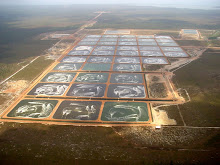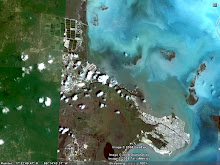I had some conversations with contacts in Belize yesterday. It appears we'll be hearing from Independence High School within a couple of weeks.
In the meantime, I'm going to begin posting a few bits of basic information and web links that we can use to help us begin thinking about the project.
Again, the basic goal of the project is to design a substrate that can be deployed in shrimp pond waste effluent canals, colonized by aquatic organisms (especially algae and bacteria) and stripped to feed shrimp. This process uses waste effluent nutrients to create a healthy, cost-effective economic resource. To be sustainble and useful, the whole process needs to have minimal materials and labor costs and needs to provide the maximum possible amount of healthy food for cultured shrimp and the maxiumum possible nutrient removal from effluents.
We will eventually need to make decisions about what substrates to use, how to deploy them, how often to deploy them, how to retrieve them,
One substrate we can use is the Aquamat. Here is a web page that has pictures of Aquamats and discusses how they work.
http://www.nurturetech.net/aqua.htm
Notice in the text that Aquamats fix (grow) between 1.3 to 0.5 g/m of nitrogen every day Phosphorus uptake will be between 25-30 mg/m/day. Most of that growth will be in the form of algae and bacteria that are desirable food items for shrimp.
For a conservative rule of thumb, let's assume we can grow about 1 gram of N per day and 0.05 g/P per day on each Aquamat.
That is enough N and P to improve water quality around the farms if..
1. Enough Aquamats are in place
2. The organisms growing on them can actually be effectively removed from the effluent canals and sedimentation ponds.
That material will be useful as feed for the farmers if….
1. The labor cost of stripping food organisms from the mats is less than the cost of feed and feeding
2. The “food” organisms promote healthy growth of the shrimp equal to or greater than the cost of similar production.
If we can devise an effective system that meets these goals we can improve both the environmental and economic sustainability of shrimp farming in Belize.
Friday, January 23, 2009
Basic info. and (shrimp) food for thought
Subscribe to:
Post Comments (Atom)




Hello!
ReplyDeleteLast Friday when Inventors Club met, we decided that it would be a good idea for us to split into 4 groups of 3 and research different topics:
A. Groups and topics of study:
Effects on environment/political (financial): Danny Ge, Gordon, Chumin
How effluents are treated in international locations: Elizabeth Russell, Adam Joseph, Fritzsche
Habitat of Shrimp/Shrimp Farming: Diana, Amy, Hadley
Materials/Aquamats: Elizabeth A, Tej, Daniel Cheng
Are there other topics you think would be a good idea for us to possibly research? We were thinking that we could post our findings on the blog, or just present it. What do you think?
Awesome!
ReplyDeleteI like! Here's some help fine tuning the focus of the groups. Let me know if the groups are ok with the adjustments.
The first group seems to be thinking broadly about the social context of shrimp aquaculture. A general narrative about the development of shrimp aquaculture industry is an important history to learn. This could span important global issues like human population growth, economic development, and the global shift from wild capture fisheries to aquaculture. Keep it general! Top it off with a quick review of the general types of shrimp farming (extensive, intensive and super-intensive) and their potential environmental effects that will set the context nicely.
The second group will need a good grasp of the ecology of eutrophication to understand how nutrient removal treatments works. You'll need to understand how nutrients affect and disturb ecosystems to understand how nutrient treatments counteract their effects. Congratulations! YOU have chosen a bottomless and infinitely complex topic! :) You'll need to learn the basics about algae and bacterial blooms, effects of nutrients on aquatic plant growth (including seagrass and mangroves) and the overall effects of adding macronutrients like nitrogen and phosphorus to aquatic ecosystems.
The third group seems ready to tackle "all things shrimpy". You are our organismal and physiological biologists. Our project is hoping to grow material that will be healthy for shrimp to eat. What do shrimp eat on shrimp farms? At what age (it is likely that our substrates will be healthiest for young post-larve or, PLs). What do they eat in the wild? What is likely to grow on our substrates that they can use as healthy food? What kinds of food should we NOT grow on our substrates?
The last group seems to be the materials scientists and engineers. They need to know everything about everything and then fuse all that information into a workable creative solution. How do we operate in this setting to build a substrate that grows good food items that can be easily transported from effluent canals to rearing ponds? Creativity involves some risk taking. Don't worry if a specific suggestion is "good" or not at first. The cream will eventually rise to the top and sometimes it's the most unlikely ideas that pay off most!
Do try to provide some form of citations.
Ask for help if you need it.
Remember to stick to facts. If something is your opinion, frame it that way and always, always be respectful.
I got more encouraging news from Belize today that I will post soon.
Great job!
Speaking on behalf of the "bottomless topic" group, I think we're going to need at least another week before we try to spit out the information. We've also been attempting to request contacts stemming from our research.
ReplyDeleteThanks for the fine-tuning, the terms you threw out should help in our research.
Liz: I'm in Peoria on friday, probably disconnected from all forms of technology. Just know that our research is going swimmingly... and if you pose any questions shoot me an email
I don't think we're in a rush here yet, ecrussel. Some people in Belize have just offered to drop by and we're still waiting to hear back from some people at the high school. Mr. Bergandine should make the final call on this, but 2 weeks seems plenty fast.
ReplyDeleteMaybe next week with the other project done and out of the way, I can drop by the school at lunch again on Friday to answer questions and help the various sections along.
I'll be getting more information about the project soon and we'll have a better idea how to proceed.
Sounds all great. Yeah, I think that this past week was very busy for us, with all the tests, so I think it would benefit everyone to have another week. We can dive in farther into the topics and refine what we are searching for. Thanks for the info! By the way Erussel, thats fine, that's why we have Diana's minutes!
ReplyDelete